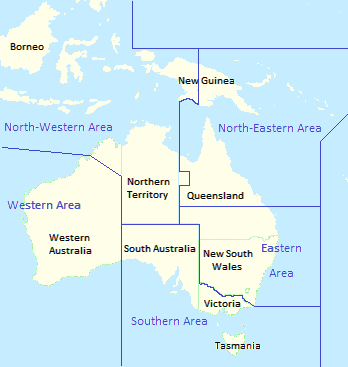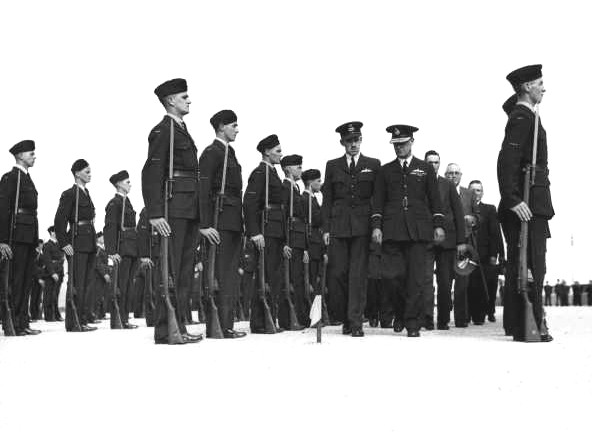|
Eastern Area Command (RAAF)
Eastern Area Command was one of several geographically based commands raised by the Royal Australian Air Force (RAAF) during . It was formed in May 1942, and controlled units located in New South Wales and southern Queensland. Headquartered in Sydney, Eastern Area Command's responsibilities included air defence, aerial reconnaissance and protection of the sea lanes within its boundaries. Its flying units operated fighters, reconnaissance bombers, and dive bombers, and concentrated on convoy escort, maritime patrol and anti-submarine warfare. The size of the area was such that the RAAF twice considered splitting it, but nothing came of this. The area command continued to function after the war, its headquarters transferring from Sydney to Glenbrook, in the Blue Mountains, in 1949. By this time most of the RAAF's operational units—including fighter, bomber, and transport wings—were based within Eastern Area's boundaries, and the officer in command was responsible for air ... [...More Info...] [...Related Items...] OR: [Wikipedia] [Google] [Baidu] |
Maritime Patrol
{{Unreferenced, date=March 2008 Maritime patrol is the task of monitoring areas of water. Generally conducted by military and law enforcement agencies, maritime patrol is usually aimed at identifying human activities. Maritime patrol refers to active patrol of an area, as opposed to passive monitoring systems such as sound-detection fixtures or land-based spotters. A patrol consists of a ship, submarine, aircraft or satellite examining the patrolled area and seeking out activities to be identified and reported. Maritime patrol is critical in wartime situations for navies to locate enemy forces to engage or defend against. Peacetime patrols are important for interdiction of criminal activities and for ensuring legal use of waters. Maritime patrols can be conducted by surface ships and submarines, by aircraft (e.g. MPA) and other aerial vehicles, and even by satellites. Human spotting remains an important part of detecting activity, but increasingly electronic systems are used. ... [...More Info...] [...Related Items...] OR: [Wikipedia] [Google] [Baidu] |
Northern Area Command (RAAF)
Northern Area Command was one of several geographically based commands raised by the Royal Australian Air Force (RAAF) during World War II. It was formed in May 1941, and covered the whole of northern Australia and Papua. Headquartered at Townsville, Queensland, Northern Area Command was responsible for air defence, aerial reconnaissance and protection of the sea lanes within its boundaries. In January 1942, following the outbreak of the Pacific War, it was divided into North-Western and North-Eastern Area Commands, to counter Japanese threats to northern Australia and Papua, respectively. History Prior to World War II, the Royal Australian Air Force was small enough for all its elements to be directly controlled by RAAF Headquarters in Melbourne. After war broke out, the RAAF began to decentralise its command structure, commensurate with expected increases in manpower and units.Stephens, ''The Royal Australian Air Force'', pp. 111–112 Between March 1940 and May 19 ... [...More Info...] [...Related Items...] OR: [Wikipedia] [Google] [Baidu] |
Western Area Command (RAAF)
Western Area Command was one of several geographically based commands raised by the Royal Australian Air Force (RAAF) during World War II. It was formed in January 1941, and controlled RAAF units located in Western Australia. Headquartered in Perth, Western Area Command was responsible for air defence, aerial reconnaissance and protection of the sea lanes within its boundaries. Its aircraft conducted anti-submarine operations throughout the war, and attacked targets in the Dutch East Indies during the Borneo campaign in 1945. The area command continued to operate after the war, but its assets and staffing were much reduced. Its responsibilities were subsumed in February 1954 by the RAAF's new functional commands: Home (operational), Training, and Maintenance Commands. Western Area headquarters was disbanded in November 1956. History World War II Prior to World War II, the Royal Australian Air Force was small enough for all its elements to be directly controlled by R ... [...More Info...] [...Related Items...] OR: [Wikipedia] [Google] [Baidu] |
Southern Area Command (RAAF)
Southern Area Command was one of several geographically based commands raised by the Royal Australian Air Force (RAAF) during . It was formed in March 1940, and initially controlled units located in Victoria, Tasmania, South Australia and southern New South Wales. Headquartered in Melbourne, Southern Area Command was responsible for air defence, aerial reconnaissance and protection of the sea lanes within its boundaries. From 1942 its operational responsibilities excluded New South Wales. The area command continued to operate following the end of the war, becoming the hub of Air Force training services. In October 1953, the RAAF began reorganising its command-and-control system from one based on geography to one based on function; Southern Area was re-formed as Training Command, which in 2006 became Air Force Training Group, a component of RAAF Air Command. History World War II Prior to World War II, the Royal Australian Air Force was small enough for all its element ... [...More Info...] [...Related Items...] OR: [Wikipedia] [Google] [Baidu] |
Central Area Command (RAAF)
Central Area Command was one of several geographically based commands raised by the Royal Australian Air Force (RAAF) during World War II. It was formed in March 1940, and covered the central portion of New South Wales. Headquartered at Sydney, Central Area Command was responsible for air defence, aerial reconnaissance and protection of the sea lanes within its boundaries. It was disbanded in August 1941 and control of its units taken over by other RAAF formations. Proposals in 1943–44 to raise a new Central Area Command did not come to fruition. History Prior to World War II, the Royal Australian Air Force was small enough for all its elements to be directly controlled by RAAF Headquarters in Melbourne. After war broke out in September 1939, the RAAF began to implement a decentralised form of command, commensurate with expected increases in manpower and units.Stephens, ''The Royal Australian Air Force'', pp. 111–112 Its initial move in this direction was to create ... [...More Info...] [...Related Items...] OR: [Wikipedia] [Google] [Baidu] |
Territory Of Papua
The Territory of Papua comprised the southeastern quarter of the island of New Guinea from 1883 to 1975. In 1883, the Government of Queensland annexed this territory for the British Empire. The United Kingdom Government refused to ratify the annexation but in 1884 a protectorate was proclaimed over the territory, then called "British New Guinea". There is a certain ambiguity about the exact date on which the entire territory was annexed by the British. The Papua Act 1905 recites that this happened "on or about" 4 September 1888.''Commonwealth and Colonial Law'' by Kenneth Roberts-Wray, London, Stevens, 1966. P. 132 On 18 March 1902, the Territory was placed under the authority of the Commonwealth of Australia. Resolutions of acceptance were passed by the Commonwealth Parliament, which accepted the territory under the name of Papua. In 1949, the Territory and the Territory of New Guinea were established in an administrative union by the name of the Territory of Papua and New Gui ... [...More Info...] [...Related Items...] OR: [Wikipedia] [Google] [Baidu] |
Melbourne
Melbourne ( ; Boonwurrung/Woiwurrung: ''Narrm'' or ''Naarm'') is the capital and most populous city of the Australian state of Victoria, and the second-most populous city in both Australia and Oceania. Its name generally refers to a metropolitan area known as Greater Melbourne, comprising an urban agglomeration of 31 local municipalities, although the name is also used specifically for the local municipality of City of Melbourne based around its central business area. The metropolis occupies much of the northern and eastern coastlines of Port Phillip Bay and spreads into the Mornington Peninsula, part of West Gippsland, as well as the hinterlands towards the Yarra Valley, the Dandenong and Macedon Ranges. It has a population over 5 million (19% of the population of Australia, as per 2021 census), mostly residing to the east side of the city centre, and its inhabitants are commonly referred to as "Melburnians". The area of Melbourne has been home to Aboriginal ... [...More Info...] [...Related Items...] OR: [Wikipedia] [Google] [Baidu] |
RAAF Air Command
Air Command is the operational arm of the Royal Australian Air Force (RAAF). It is headed by the Air Commander Australia, whose role is to manage and command the RAAF's Force Element Groups (FEGs), which contain the operational capability of the Air Force. Headquarters Air Command is located at RAAF Base Glenbrook. Structure Air Command consists of the following FEGs: *Air Mobility Group RAAF, Air Mobility Group *Air Combat Group RAAF, Air Combat Group *Surveillance and Response Group RAAF, Surveillance and Response Group *Combat Support Group RAAF, Combat Support Group *Air Warfare Centre RAAF, Air Warfare Centre *Air Force Training Group RAAF, Air Force Training Group Air Command has a critical strategic role both in peacetime and wartime. It works closely with Air Force Training Group RAAF, Air Force Training Group (formerly RAAF Training Command) and the Australian Defence Force's Joint Logistics Command in developing and maintaining the nation's defence capabilities. Comma ... [...More Info...] [...Related Items...] OR: [Wikipedia] [Google] [Baidu] |
RAAF Operational Command
"Through Adversity to the Stars" , colours = , colours_label = , march = , mascot = , anniversaries = RAAF Anniversary Commemoration – 31 March , equipment = , equipment_label = , battles = * Second World War * Berlin Airlift * Korean War * Malayan Emergency * Indonesia–Malaysia Confrontation * Vietnam War * East Timor * War in Afghanistan * Iraq War * Military intervention against ISIL , decorations = , battle_honours = , battle_honours_label = , flying_hours = , website = , commander1 = Governor-General David Hurley as representative of Charles III as King of Australia , commander1_label = Commander-in-Chief , commander2 = General Angus Campbell , commander2_ ... [...More Info...] [...Related Items...] OR: [Wikipedia] [Google] [Baidu] |
RAAF Home Command
"Through Adversity to the Stars" , colours = , colours_label = , march = , mascot = , anniversaries = RAAF Anniversary Commemoration – 31 March , equipment = , equipment_label = , battles = * Second World War * Berlin Airlift * Korean War * Malayan Emergency * Indonesia–Malaysia Confrontation * Vietnam War * East Timor * War in Afghanistan * Iraq War * Military intervention against ISIL , decorations = , battle_honours = , battle_honours_label = , flying_hours = , website = , commander1 = Governor-General David Hurley as representative of Charles III as King of Australia , commander1_label = Commander-in-Chief , commander2 = General Angus Campbell , commander2_ ... [...More Info...] [...Related Items...] OR: [Wikipedia] [Google] [Baidu] |





